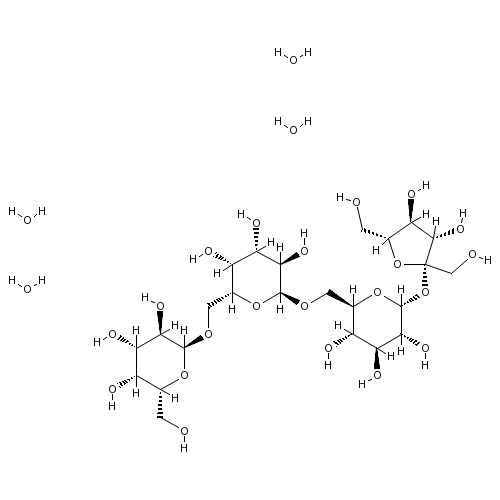Stachyose tetrahydrateCAS# 470-55-3 |

Quality Control & MSDS
3D structure
Package In Stock
Number of papers citing our products

| Cas No. | 470-55-3 | SDF | Download SDF |
| PubChem ID | 2724335 | Appearance | Powder |
| Formula | C24H50O25 | M.Wt | 738.64 |
| Type of Compound | N/A | Storage | Desiccate at -20°C |
| Solubility | Soluble in Chloroform,Dichloromethane,Ethyl Acetate,DMSO,Acetone,etc. | ||
| Chemical Name | (2S,3R,4S,5R,6R)-2-[[(2R,3R,4S,5R,6S)-6-[[(2R,3S,4S,5R,6R)-6-[(2S,3S,4S,5R)-3,4-dihydroxy-2,5-bis(hydroxymethyl)oxolan-2-yl]oxy-3,4,5-trihydroxyoxan-2-yl]methoxy]-3,4,5-trihydroxyoxan-2-yl]methoxy]-6-(hydroxymethyl)oxane-3,4,5-triol;tetrahydrate | ||
| SMILES | C(C1C(C(C(C(O1)OCC2C(C(C(C(O2)OCC3C(C(C(C(O3)OC4(C(C(C(O4)CO)O)O)CO)O)O)O)O)O)O)O)O)O)O.O.O.O.O | ||
| Standard InChIKey | KUVZQLSUXDNGAW-QPIIYOCQSA-N | ||
| Standard InChI | InChI=1S/C24H42O21.4H2O/c25-1-6-10(28)14(32)17(35)21(41-6)39-3-8-11(29)15(33)18(36)22(42-8)40-4-9-12(30)16(34)19(37)23(43-9)45-24(5-27)20(38)13(31)7(2-26)44-24;;;;/h6-23,25-38H,1-5H2;4*1H2/t6-,7-,8-,9-,10+,11+,12-,13-,14+,15+,16+,17-,18-,19-,20+,21+,22+,23-,24+;;;;/m1..../s1 | ||
| General tips | For obtaining a higher solubility , please warm the tube at 37 ℃ and shake it in the ultrasonic bath for a while.Stock solution can be stored below -20℃ for several months. We recommend that you prepare and use the solution on the same day. However, if the test schedule requires, the stock solutions can be prepared in advance, and the stock solution must be sealed and stored below -20℃. In general, the stock solution can be kept for several months. Before use, we recommend that you leave the vial at room temperature for at least an hour before opening it. |
||
| About Packaging | 1. The packaging of the product may be reversed during transportation, cause the high purity compounds to adhere to the neck or cap of the vial.Take the vail out of its packaging and shake gently until the compounds fall to the bottom of the vial. 2. For liquid products, please centrifuge at 500xg to gather the liquid to the bottom of the vial. 3. Try to avoid loss or contamination during the experiment. |
||
| Shipping Condition | Packaging according to customer requirements(5mg, 10mg, 20mg and more). Ship via FedEx, DHL, UPS, EMS or other couriers with RT, or blue ice upon request. | ||

Stachyose tetrahydrate Dilution Calculator

Stachyose tetrahydrate Molarity Calculator
| 1 mg | 5 mg | 10 mg | 20 mg | 25 mg | |
| 1 mM | 1.3538 mL | 6.7692 mL | 13.5384 mL | 27.0768 mL | 33.846 mL |
| 5 mM | 0.2708 mL | 1.3538 mL | 2.7077 mL | 5.4154 mL | 6.7692 mL |
| 10 mM | 0.1354 mL | 0.6769 mL | 1.3538 mL | 2.7077 mL | 3.3846 mL |
| 50 mM | 0.0271 mL | 0.1354 mL | 0.2708 mL | 0.5415 mL | 0.6769 mL |
| 100 mM | 0.0135 mL | 0.0677 mL | 0.1354 mL | 0.2708 mL | 0.3385 mL |
| * Note: If you are in the process of experiment, it's necessary to make the dilution ratios of the samples. The dilution data above is only for reference. Normally, it's can get a better solubility within lower of Concentrations. | |||||

Calcutta University

University of Minnesota

University of Maryland School of Medicine

University of Illinois at Chicago

The Ohio State University

University of Zurich

Harvard University

Colorado State University

Auburn University

Yale University

Worcester Polytechnic Institute

Washington State University

Stanford University

University of Leipzig

Universidade da Beira Interior

The Institute of Cancer Research

Heidelberg University

University of Amsterdam

University of Auckland

TsingHua University

The University of Michigan

Miami University

DRURY University

Jilin University

Fudan University

Wuhan University

Sun Yat-sen University

Universite de Paris

Deemed University

Auckland University

The University of Tokyo

Korea University
- Marinobufagin
Catalog No.:BCC9238
CAS No.:470-42-8
- Cinobufagin
Catalog No.:BCN5367
CAS No.:470-37-1
- Isoalantolactone
Catalog No.:BCN4955
CAS No.:470-17-7
- Uncarine D
Catalog No.:BCC8262
CAS No.:4697-68-1
- Carbenicillin
Catalog No.:BCC5192
CAS No.:4697-36-3
- 5'-IMPdisodium salt
Catalog No.:BCN8175
CAS No.:4691-65-0
- Jervine
Catalog No.:BCN2975
CAS No.:469-59-0
- Cycloeucalenol
Catalog No.:BCN5519
CAS No.:469-39-6
- Hamamelitannin
Catalog No.:BCC8182
CAS No.:469-32-9
- BMS-536924
Catalog No.:BCC1177
CAS No.:468740-43-4
- Cimilactone A
Catalog No.:BCN7948
CAS No.:468733-06-4
- 3-Benzofurancarboxaldehyde
Catalog No.:BCC8622
CAS No.:4687-25-6
- 1-Kestose
Catalog No.:BCN8292
CAS No.:470-69-9
- Cineole
Catalog No.:BCN2686
CAS No.:470-82-6
- Benzoyl-DL-methionine
Catalog No.:BCC8863
CAS No.:4703-38-2
- Beta-Lapachone
Catalog No.:BCC5088
CAS No.:4707-32-8
- alpha-Lapachone
Catalog No.:BCN5520
CAS No.:4707-33-9
- Atraric acid
Catalog No.:BCN5521
CAS No.:4707-47-5
- 8-Amino-7-oxononanoic acid
Catalog No.:BCN1778
CAS No.:4707-58-8
- Glycyrrhetinic acid
Catalog No.:BCN5942
CAS No.:471-53-4
- Isocolumbin
Catalog No.:BCN5361
CAS No.:471-54-5
- alpha-Boswellic acid
Catalog No.:BCN5522
CAS No.:471-66-9
- Dipterocarpol
Catalog No.:BCN5523
CAS No.:471-69-2
- (-)-Steviol
Catalog No.:BCN8358
CAS No.:471-80-7
Proteomic analysis of stachyose contribution to the growth of Lactobacillus acidophilus CICC22162.[Pubmed:29767655]
Food Funct. 2018 May 23;9(5):2979-2988.
Stachyose is a functional oligosaccharide, acting as a potential prebiotic for colonic fermentation. To understand the mechanism of how stachyose promotes the growth of probiotic bacterium, we analyzed the differences of the proteome of Lactobacillus acidophilus grown on stachyose or glucose. By a combination of two-dimensional electrophoresis and mass spectrometry analysis, we observed 16 proteins differentially abundant under these two conditions and identified 9 protein spots. Six of these proteins were highly abundant when stachyose was used as the sole carbon source. They included the phosphotransferase system, the energy coupling factor (ECF) transporter and the mannose-6-phosphate isomerase, involved in the uptake and catabolism of stachyose in Lactobacillus acidophilus CICC22162. Supportively, these observations were validated by quantitative RT-PCR analysis and enzymatic activity determination. Positive correlation was found between the content of the proteins and their mRNA levels. Additionally, we explored the recognition mechanism for stachyose binding to the newly identified ECF transporter by MD simulations and free energy analysis. Taken together, these results provide new insights into the mechanism of stachyose in promoting the growth of probiotic bacterium.


